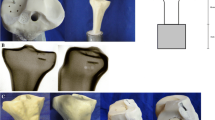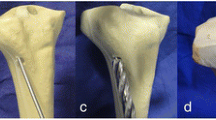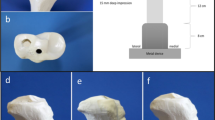Abstract
Purpose
The aim of this study was to investigate a new drillable calcium phosphate cement (Norian drillable Synthes GmbH) as a bone substitute either alone or in combination with screws in the jail technique (Petersen et al. Unfallchirurg Mar 109(3):219–234, 2006; Petersen et al. Unfallchirurg Mar 109(3):235–244, 2006) with regard to the primary stability in lateral tibial depression fractures.
Methods
Lateral depression fractures of the tibial plateau were created in a biomechanical fracture model. After reduction they were stabilised with bone substitute (group one), bone substitute with additional four screws in the jail technique (group two) or four screws only (group three). Displacement under cyclic loading, stiffness and maximum load in load-to-failure tests were determined.
Results
The groups with the bone substitute showed a lower displacement of the depressed articular fragment under cyclical loading and a higher stiffness. The maximum load was higher for the groups with screws.
Conclusions
Only the combination of bone substitute and screws prevented secondary loss of reduction and, at the same time, provided enough stability under maximum load.





Similar content being viewed by others
References
Wiss, DA (2006) Master techniques in orthopaedic surgery fractures. Lippincott Williams & Wilking
Kösters C, Schliemann B, Raschke MJ (2011) Tibial head fractures in the elderly. Unfallchirurg 114(3):251–260
Yetkinler DN, McClellan RT, Reindel ES, Carter D, Poser RD (2001) Biomechanical comparison of conventional open reduction and internal fixation versus calcium phosphate cement fixation of a central depressed tibial plateau fracture. J Orthop Trauma 15(3):197–206
Welch RD, Zhang H, Bronson DG (2003) Experimental tibial plateau fractures augmented with calcium phosphate cement or autologous bone graft. J Bone Joint Surg Am 85-A(2):222–231
Zahn RK, Frey S, Jakubietz RG, Jakubietz MG, Doht S, Schneider P, Waschke J, Meffert RH (2012) A contoured locking plate for distal fibular fractures in osteoporotic bone: A biomechanical cadaver study. Injury 43(6):718–725
Braun MJ, Meta MD, Schneider P, Reiners C (1998) Clinical evaluation of a high-resolution new peripheral quantitative computerized tomography (pQCT) scanner for the bone densitometry at the lower limbs. Phys Med Biol 43(8):2279–2294
Guglielmi G, Schneider P, Lang TF, Giannatempo GM, Cammisa M, Genant HK (1997) Quantitative computed tomography at the axial and peripheral skeleton. Eur Radiol 7(Suppl 2):S32–S42
Karunakar MA, Egol KA, Peindl R, Harrow ME, Bosse MJ, Kellam JF (2002) Split depression tibial plateau fractures: a biomechanical study. J Orthop Trauma 16(3):172–177
Petersen W, Zantop T, Raschke M (2006) Fracture of the tibial head. Unfallchirurg Mar 109(3):219–234
Petersen W, Zantop T, Raschke M (2006) Tibial head fracture open reposition and osteosynthesis-arthroscopic reposition and osteosynthesis (ARIF). Unfallchirurg Mar 109(3):235–244
Wirth CJ, Mutschler W, Bischoff HP, Pueschmann H, Neu J (2010) Komplikationen in Orthopaedie und Unfallchirurgie. Thieme Verlag
Raschke M, Stange R (2009) Alterstraumatologie, 1st ed. Urban & Fischer
McDonald E, Chu T, Tufaga M, Marmor M, Singh R, Yetkinler D, Matityahu A, Buckley JM, McClellan RT (2011) Tibial plateau fracture repairs augmented with calcium phosphate cement have higher in situ fatigue strength than those with autograft. J Orthop Trauma 25(2):90–95
Ratcliff JR, Werner FW, Green JK, Harley BJ (2007) Medial buttress versus lateral locked plating in a cadaver medial tibial plateau fracture model. J Orthop Trauma 21(7):444–448
Acknowledgement
The authors would like to thank Dr. Maria Moritz and Prof. Dr. Peter Schneider for supporting the measurement of the bone mineral density. Furthermore, they would like to thank Jürgen Schmid from Synthes GmbH for providing the drillable calcium phosphate cement, Norian drillable. The authors would also like to thank Gabi Walter from Heraeus Medical GmbH for supplying the bone cement, Palacos.
Conflict of interest
The authors declare that they have no conflict of interest.
Author information
Authors and Affiliations
Corresponding author
Rights and permissions
About this article
Cite this article
Doht, S., Lehnert, T., Frey, S. et al. Effective combination of bone substitute and screws in the jail technique: a biomechanical study of tibial depression fractures. International Orthopaedics (SICOT) 36, 2121–2125 (2012). https://doi.org/10.1007/s00264-012-1604-8
Received:
Accepted:
Published:
Issue Date:
DOI: https://doi.org/10.1007/s00264-012-1604-8




